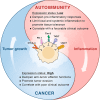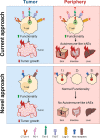The yin and yang of co-inhibitory receptors: toward anti-tumor immunity without autoimmunity
- PMID: 31974523
- PMCID: PMC7118128
- DOI: 10.1038/s41422-020-0277-x
The yin and yang of co-inhibitory receptors: toward anti-tumor immunity without autoimmunity
Erratum in
-
Author Correction: The yin and yang of co-inhibitory receptors: toward anti-tumor immunity without autoimmunity.Cell Res. 2020 Apr;30(4):366. doi: 10.1038/s41422-020-0285-x. Cell Res. 2020. PMID: 32086475 Free PMC article.
Abstract
Co-inhibitory receptors are important regulators of T-cell function that define the balance between tolerance and autoimmunity. The immune regulatory function of co-inhibitory receptors, including CTLA-4, PD-1, TIM-3, TIGIT, and LAG-3, was first discovered in the setting of autoimmune disease models, in which their blockade or deficiency resulted in induction or exacerbation of the disease. Later on, co-inhibitory receptors on lymphocytes have also been found to influence outcomes in tumor and chronic viral infection settings. These receptors suppress T-cell function in the tumor microenvironment (TME), thereby making the T cells dysfunctional. Based on this observation, blockade of co-inhibitory receptors (also known as checkpoint molecules) has emerged as a successful treatment option for a number of human cancers. However, severe autoimmune-like side effects limit the use of therapeutics that block individual or combinations of co-inhibitory receptors for cancer treatment. In this review we provide an overview of the role of co-inhibitory receptors in autoimmunity and anti-tumor immunity. We then discuss current approaches and future directions to leverage our knowledge of co-inhibitory receptors to target them in tumor immunity without inducing autoimmunity.
Conflict of interest statement
The authors declare no competing interests.
Figures




Similar articles
-
Targeting novel inhibitory receptors in cancer immunotherapy.Semin Immunol. 2020 Jun;49:101436. doi: 10.1016/j.smim.2020.101436. Epub 2020 Dec 4. Semin Immunol. 2020. PMID: 33288379 Free PMC article. Review.
-
TIGIT: An emerging immune checkpoint target for immunotherapy in autoimmune disease and cancer.Int Immunopharmacol. 2023 Jul;120:110358. doi: 10.1016/j.intimp.2023.110358. Epub 2023 May 31. Int Immunopharmacol. 2023. PMID: 37262959 Review.
-
Immune Co-inhibitory Receptors PD-1, CTLA-4, TIM-3, LAG-3, and TIGIT in Medullary Thyroid Cancers: A Large Cohort Study.J Clin Endocrinol Metab. 2021 Jan 1;106(1):120-132. doi: 10.1210/clinem/dgaa701. J Clin Endocrinol Metab. 2021. PMID: 33000173
-
TIGIT, A Novel Therapeutic Target for Tumor Immunotherapy.Immunol Invest. 2017 Feb;46(2):172-182. doi: 10.1080/08820139.2016.1237524. Epub 2016 Nov 7. Immunol Invest. 2017. PMID: 27819527 Review.
-
Immune checkpoint receptors in autoimmunity.Curr Opin Immunol. 2023 Feb;80:102283. doi: 10.1016/j.coi.2023.102283. Epub 2023 Jan 28. Curr Opin Immunol. 2023. PMID: 36709596 Free PMC article. Review.
Cited by
-
A computational study of co-inhibitory immune complex assembly at the interface between T cells and antigen presenting cells.PLoS Comput Biol. 2021 Mar 8;17(3):e1008825. doi: 10.1371/journal.pcbi.1008825. eCollection 2021 Mar. PLoS Comput Biol. 2021. PMID: 33684103 Free PMC article.
-
Blockade of novel immune checkpoints and new therapeutic combinations to boost antitumor immunity.J Exp Clin Cancer Res. 2022 Feb 14;41(1):62. doi: 10.1186/s13046-022-02264-x. J Exp Clin Cancer Res. 2022. PMID: 35164813 Free PMC article. Review.
-
High-Throughput Strategies for the Discovery of Anticancer Drugs by Targeting Transcriptional Reprogramming.Front Oncol. 2021 Oct 1;11:762023. doi: 10.3389/fonc.2021.762023. eCollection 2021. Front Oncol. 2021. PMID: 34660328 Free PMC article. Review.
-
Colorectal Cancer-Associated Immune Exhaustion Involves T and B Lymphocytes and Conventional NK Cells and Correlates With a Shorter Overall Survival.Front Immunol. 2021 Dec 16;12:778329. doi: 10.3389/fimmu.2021.778329. eCollection 2021. Front Immunol. 2021. PMID: 34975867 Free PMC article.
-
Pulsed Radiation Therapy to Improve Systemic Control of Metastatic Cancer.Front Oncol. 2021 Aug 23;11:737425. doi: 10.3389/fonc.2021.737425. eCollection 2021. Front Oncol. 2021. PMID: 34497773 Free PMC article.
References
Publication types
MeSH terms
Substances
Grants and funding
LinkOut - more resources
Full Text Sources
Other Literature Sources
Medical
Research Materials

